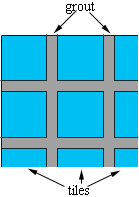| |||
| Math Central | Quandaries & Queries |
|
Question from rustom, a student: (a) Find the volume of water in swimming pool with vertical ends and sides I got the (a) question but I don't know the (b) question which have the answer |
Hi Rustom,
I found the wording of part (b) confusing. I think that by "1/20 of the surface area is covered by sealing material" that 1/20 of the surface area is taken up by the grout between the tiles so that only 19/20 of the surface area is covered by the tiles.

I found the surface area of the 5 pieces making sure that the heights of the sides were increased by 2 feet and using Pythagoras' Theorem to find the length of the bottom. I got 2139.19 square feet. The surface area covered by the tiles is then
$\frac{19}{20} \times 2123.19 = 2017.04$ square feet.
Each tile covers $\frac{3}{12} \times \frac{6}{12} = \frac{1}{8}$ square feet so it takes 8 tiles to cover 1 square foot. Hence you will need $8 \times 2017.04 = 16136.28$ tiles. You need to check all my arithmetic.
If this were an actual project you would need to round up. The tiles won't fit exactly and some will need to be cut producing some wastage.
Penny
 |
||
Math Central is supported by the University of Regina and The Pacific Institute for the Mathematical Sciences.